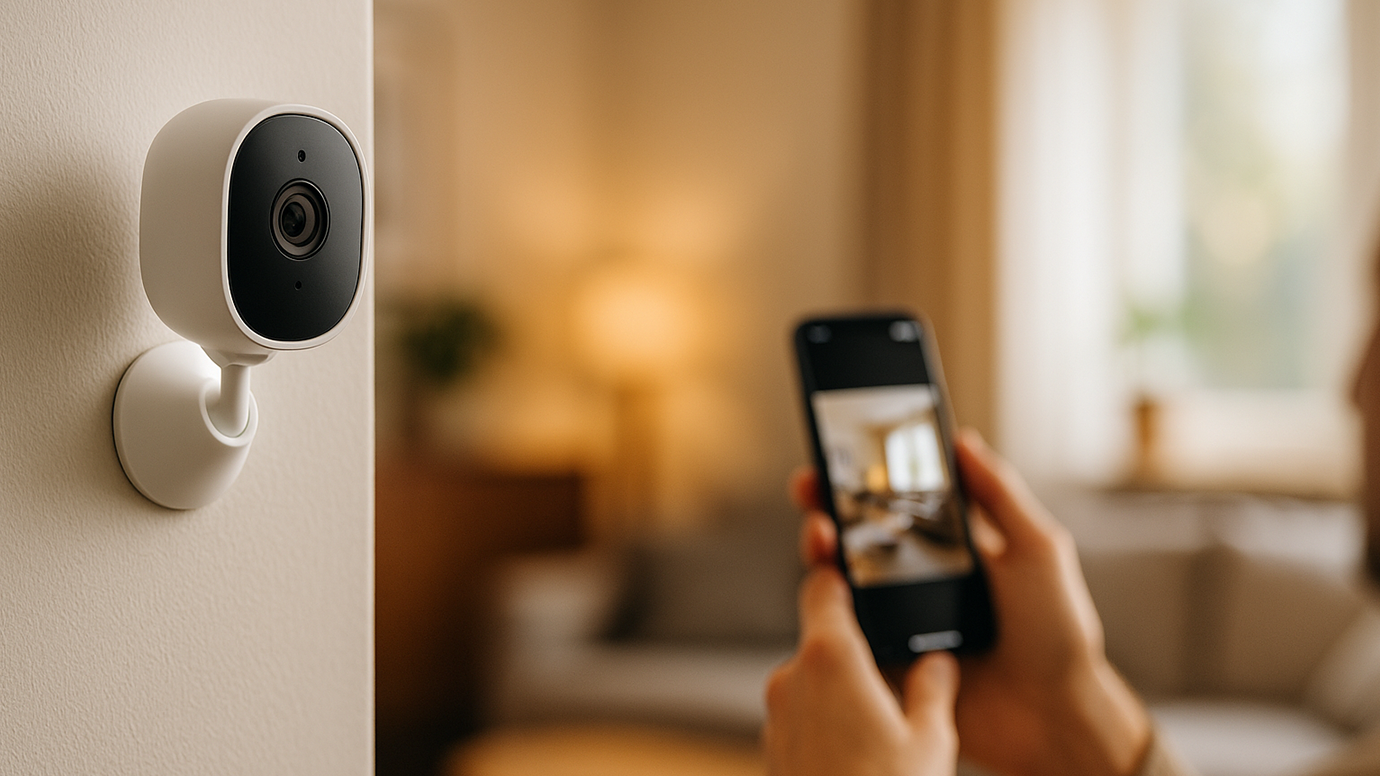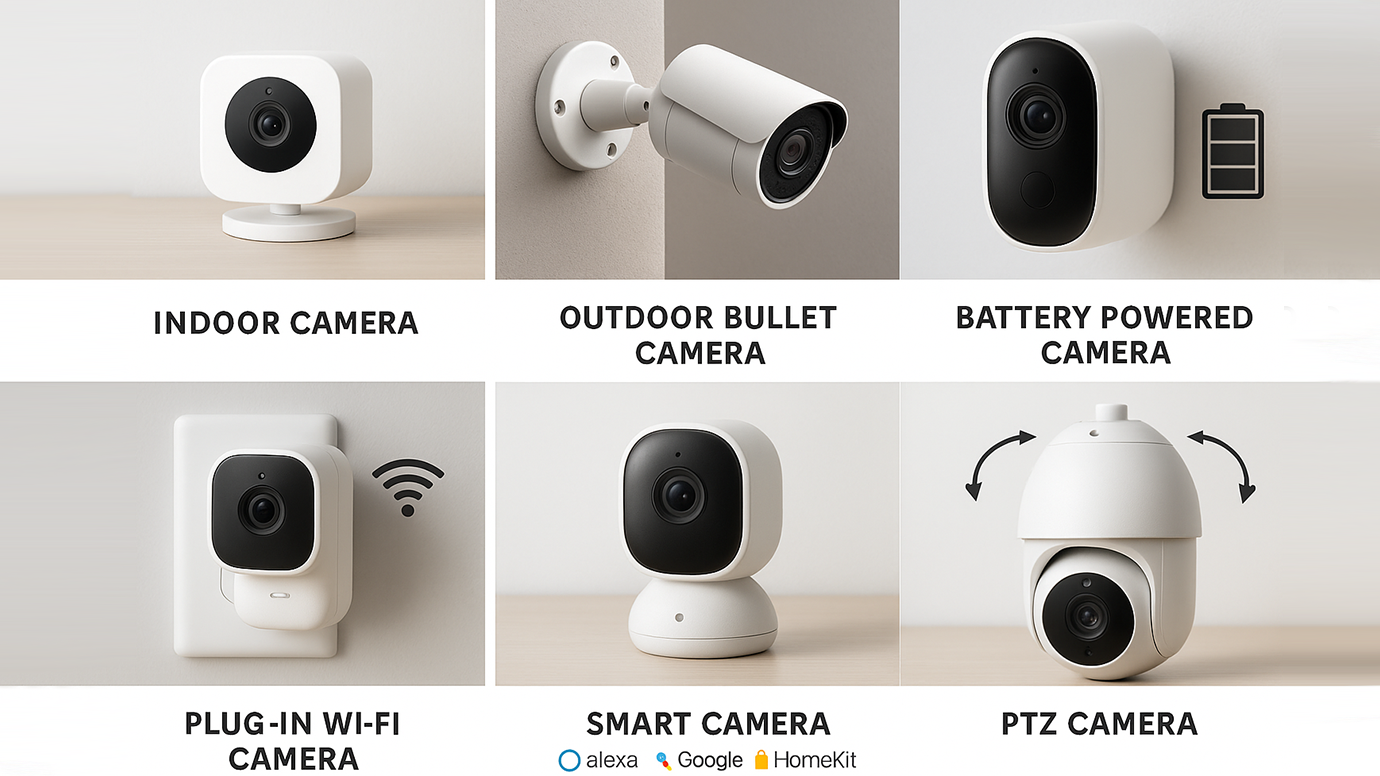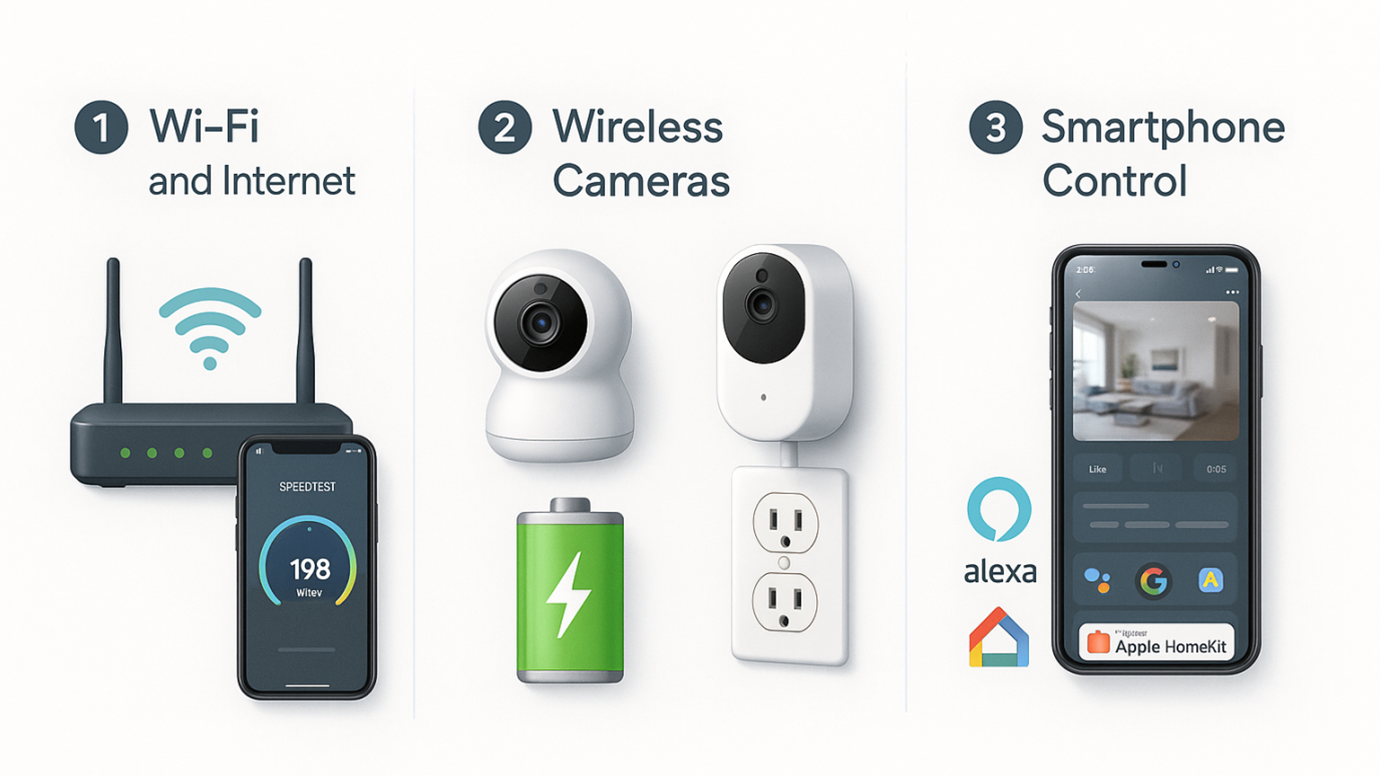Wireless Camera Setup
A wireless security camera is a modern surveillance device that works over Wi-Fi instead of relying on traditional cables. This makes it one of the easiest security cameras to install, even for beginners. Unlike wired systems, you don’t have to deal with complicated drilling or messy cables. Many people also prefer battery powered wireless security cameras, since they don’t require a constant power outlet, giving you the freedom to place them wherever security matters most — inside your home, outside on the porch, or even in your office.
Homeowners use these devices for home security to monitor doors, windows, and garages. A proper wireless security camera setup for home gives you peace of mind, helping you keep an eye on suspicious activity and protect your loved ones. Offices also benefit from wireless cam setup, as it ensures workplace safety, reduces theft, and improves overall security.
Another advantage is the ability to monitor remotely. With a smartphone app, you can easily set up a surveillance camera at home and access live video feeds no matter where you are. Whether traveling or managing a business, wireless camera setup allows you to check in at any time. For larger installations, modern systems also support NVR camera system setup, which records and stores footage from multiple cameras in one place.
If you’ve been wondering how to install wireless camera systems, don’t worry. Setting up these devices doesn’t require advanced technical knowledge. In this blog, we’ll walk you through a simple, step-by-step wireless security camera setup process.
Types of Wireless Cameras
When you decide to install a wireless security camera, choosing the right type is the first and most important step. Different cameras serve different purposes, and the best choice depends on whether you want to monitor indoors, outdoors, or both. Below are the most common types of wireless security cameras and how they fit into your home or office.
-
Indoor vs. Outdoor Cameras
Indoor wireless security cameras are compact, discreet, and designed to blend with your home décor. They are perfect if you want to set up a surveillance camera at home to monitor hallways, kids’ rooms, or living areas. On the other hand, outdoor cameras are rugged and weatherproof, built to withstand rain, dust, and heat. Outdoor models often include features like night vision and motion detection to keep your property safe around the clock. For exposed areas such as driveways or gates, a bullet camera is a reliable choice because it provides a clear, focused view of specific zones.
-
Battery Powered Wireless Security Cameras
For those who want complete flexibility, battery powered wireless security cameras are the way to go. Since they don’t need constant power, they are portable and easy to move around. These are among the easiest security cameras to install because there’s no wiring involved — just set up the camera where you need it most. However, you’ll need to recharge or replace the batteries periodically. They are ideal for temporary surveillance or locations without easy access to power outlets.
-
Plug-in WiFi Cameras
Plug-in WiFi cameras connect directly to a wall outlet, ensuring stable and continuous power. This type of cam setup is best for areas where the camera will stay in a fixed position for long periods. The installation is simple: just plug in, connect to WiFi, and follow the app instructions for camera setup. These are popular for both homes and small offices where downtime is not acceptable.
-
Smart Cameras
Smart wireless security cameras are designed to integrate with home automation systems such as Alexa, Google Home, or Apple HomeKit. This allows you to control and monitor your cam setup with voice commands or directly from your smart home dashboard. With these cameras, you can receive instant alerts on your phone when motion is detected. They are perfect if you want a modern, connected camera setup that works seamlessly with other smart devices.
-
PTZ Cameras (Pan-Tilt-Zoom)
For wide coverage and advanced monitoring, PTZ camera installation is the best option. These cameras can pan, tilt, and zoom, giving you full control over the viewing angle through a mobile app. PTZ cameras are commonly used in offices, warehouses, or large homes where a single fixed camera won’t cover all areas. If you’re exploring how to install wireless camera systems with advanced features, PTZ models offer the flexibility you need. They can also be integrated into an NVR camera system setup, making them ideal for large multi-camera surveillance networks.
By understanding these types of cameras, you’ll be able to choose the right device for your needs. Whether you want a bullet camera for outdoor monitoring, battery powered wireless security cameras for flexibility, or a full PTZ camera installation for advanced control, the right choice will make your security camera setup more effective and reliable.
Things to Check Before Wireless Camera Setup
Before you start your wireless camera setup, it’s important to prepare properly so that your system runs smoothly and provides reliable security. Many homeowners rush to install wireless security cameras without considering the basics, which can lead to weak signals, poor video quality, or unnecessary frustration. If you’re planning for a complete security camera setup for home and office, here are three key things you must check first.
-
Internet Speed & Wi-Fi Coverage
A wireless security camera depends on your Wi-Fi connection to stream and record video. If your internet speed is slow, or if certain areas of your home have weak coverage, your cam setup may struggle with buffering or disconnections. Before you set up cameras, run a quick speed test near the location where you want to place them. Ideally, you should have at least 2 Mbps upload speed per camera for smooth streaming. For outdoor spaces, such as where you’d mount a bullet camera, consider using Wi-Fi extenders to improve coverage. A strong network ensures your security camera setup captures footage in real time without interruptions.
-
Power Source Availability
Depending on the type of camera, power can be a major factor in your security camera setup for home. If you choose battery powered wireless security cameras, you’ll enjoy flexibility since they don’t need to be near a socket. However, you’ll need to remember to recharge or replace the batteries regularly. For plug-in models, make sure a power outlet is within reach before you install wireless security cameras. Outdoor devices like bullet cameras or advanced systems that require PTZ camera installation should ideally have a dedicated power source for uninterrupted operation. Proper planning ensures you won’t have to relocate your cameras later.
-
Device and App Compatibility
Modern home security camera installation often includes connecting cameras to smartphones, tablets, or even smart home systems. Before you set up surveillance cameras at home, check that the camera’s app is compatible with your device (iOS, Android, or smart home hubs like Alexa or Google Home). If you’re exploring how to install wireless camera systems with advanced controls, you’ll want to make sure the app allows smooth pan, tilt, and zoom functions. Compatibility checks save time and prevent frustration during cam setup.
Preparing these three essentials before your wireless camera setup will make the installation process faster, easier, and more reliable. Taking these steps ensure you’ll get the best performance from your devices and avoid common setup mistakes.
Step-by-Step Wireless Camera Setup
Setting up a wireless security camera doesn’t have to be complicated. Most modern devices are designed to be beginner-friendly and are among the easiest security cameras to install. Follow this step-by-step checklist to complete your camera setup without hassle:
Step 1: Unbox & Power the Camera
- Carefully unbox the device and check all accessories (mounting kit, cables, screws, or batteries).
- For battery powered wireless security cameras, fully charge the battery before use.
- For plug-in models, connect the adapter to a reliable power outlet.
- Ensuring a proper power supply prevents interruptions during your cam setup.
Step 2: Download the App & Create an Account
- Find the brand-specific app in the App Store or Google Play.
- Download and install it on your smartphone or tablet.
- Create an account or log in to link your camera to the app.
- This step is essential for home security camera installation, remote viewing, and alerts when you set up surveillance cameras at home.
Step 3: Connect Camera to Wi-Fi (2.4 GHz vs. 5 GHz)
- Open the app and select set up camera or add device.
- Connect the wireless security camera to your Wi-Fi network.
- Most devices prefer 2.4 GHz networks for stronger range; some also support 5 GHz for higher speeds.
- Stable Wi-Fi ensures smooth streaming, especially if you’re planning a larger NVR camera system setup.
Step 4: Mount Camera in the Ideal Location
- For outdoor monitoring, use a bullet camera since it is weatherproof and durable.
- For indoor areas, select corners that cover entryways, living rooms, or hallways.
- Consider PTZ camera installation if you need wide coverage with pan, tilt, and zoom control.
- Avoid blind spots and ensure the camera is within strong Wi-Fi range.
- Proper placement is the foundation of an effective security camera setup for home.
Step 5: Configure Motion Detection, Alerts, and Storage
- Enable motion detection to receive instant alerts on your phone when movement is detected.
- Adjust sensitivity to reduce false alarms from pets or passing vehicles.
- Choose storage options: cloud storage, SD card, or integration with an NVR camera system setup.
- Finalize app preferences, such as night vision, scheduling, or audio settings.
- These configurations ensure your security camera setup is optimized for safety and convenience.
With these five steps, you now know exactly how to install wireless cameras quickly and efficiently. If you’re creating a complete security camera setup for home, this section makes the process simple and reliable.
Common Issues during Wireless Camera Setup & Troubleshooting Tips
Even the easiest security cameras can sometimes present challenges during setup. Whether you’re using a compact indoor device, a durable bullet camera outdoors, or advanced options like battery powered wireless security cameras, you might face common issues. The good news is that most of these problems have simple fixes.
-
Wi-Fi Connectivity Problems
One of the most common issues during wireless camera setup is a failure to connect to Wi-Fi. This usually happens when the security camera is too far from the router, when the signal is weak, or when the camera doesn’t support the Wi-Fi frequency you’re trying to use (2.4 GHz vs. 5 GHz). To fix this, move your router closer to the device or use a Wi-Fi extender to strengthen the signal. Always check whether your model supports the network band you’re connecting to. If the problem continues, reset the camera and repeat the security camera setup process.
-
Video Lag or Poor Quality
Another frequent complaint is video lag, buffering, or blurry footage after you set up the camera. These issues are usually linked to low internet speed or congestion on your home network. For a smoother setup, run an internet speed test to ensure you have enough upload bandwidth (ideally at least 2 Mbps per camera). If speeds are insufficient, lower the resolution settings in the app to improve stability. For outdoor setups, like when using a bullet camera, ensure it has a clear line of sight to the router for the best performance.
-
App Not Syncing With the Wireless Camera
Sometimes, the mobile app won’t sync with the device during home security camera installation. This can prevent you from viewing live feeds or adjusting important settings. To resolve this, update the app to the latest version, then reboot both the router and the camera before retrying the cam setup. For advanced models, confirm that your phone or tablet is compatible with the app’s features, since older devices may not support advanced controls.
-
Storage and Recording Issues
Even after a successful security camera setup for home, you may encounter problems with recordings not saving properly. Cloud storage might fail to sync, or an SD card may not be recognized. The solution is to double-check your storage settings in the app and confirm that any required subscriptions are active. If you’re using an SD card, ensure it’s compatible with the device. For larger or multi-camera systems, connecting the devices to an NVR camera system setup is often the best way to ensure reliable and centralized recording.
-
Device Freezing or Random Resets
In some cases, a wireless security camera may freeze, lag, or restart unexpectedly. These issues are typically caused by outdated firmware or software bugs. To fix this, update the device firmware through the app. If the issue persists, reset the camera to its factory settings and repeat the setup process from the beginning. This often resolves glitches and restores smooth operation.
By understanding these common issues and applying the right fixes, you can keep your security camera working flawlessly. Whether you’re simply trying to set up surveillance cameras at home or managing an advanced NVR camera system setup, these troubleshooting tips will help ensure your system remains reliable and effective.
FAQs
Q1. What is a wireless security camera and how does it work?
- A. A wireless security camera records video and audio and transmits the data via Wi-Fi instead of cables. This makes camera setup much easier compared to traditional wired systems. You can monitor live footage on your phone and even store recordings in the cloud or through an NVR camera system setup.
Q2. Are battery powered wireless security cameras reliable for long-term use?
- A. Yes, battery powered wireless security cameras are highly reliable for flexible placements where power outlets are not available. While they need periodic recharging or battery replacement, they are among the easiest security cameras to install and are great for temporary or hard-to-reach locations.
Q3. Can I do a home security camera installation on my own?
- A. Yes, many people choose to install wireless security cameras on their own. But taking a professional help would ensure smooth and hassle-free setup without any issues.
Q4. Is an NVR camera system setup necessary for home users?
- A. An NVR camera system setup isn’t always necessary for basic installation, but it’s extremely useful if you have multiple cameras. It centralizes video storage and makes managing several devices easier, ensuring a professional-grade security camera setup at home or in offices.
Q5. What should I do if my wireless security camera is not connecting to Wi-Fi?
- A. If your wireless security camera fails to connect, move it closer to the router or use a Wi-Fi extender. Check that you’re on the correct frequency band (2.4 GHz vs. 5 GHz). If problems continue, reset the camera and repeat the process for a fresh camera setup.
Conclusion
Setting up a wireless security camera has never been easier. With the right preparation, you can quickly complete your camera setup and enjoy the peace of mind that comes with 24/7 surveillance. From unboxing and powering your device to connecting it to Wi-Fi, choosing the right placement, and configuring storage, each step ensures your security camera setup for home or office runs smoothly. Whether you’re working with compact indoor models, rugged outdoor options like a bullet camera, or even advanced battery powered wireless security cameras, following a clear guide helps you avoid confusion and get the best results.
One of the biggest advantages of modern systems is flexibility. You can install wireless security cameras almost anywhere, integrate them into a larger NVR camera system setup, or choose advanced devices that support PTZ camera installation for wide coverage and control. For homeowners, this means it’s possible to set up surveillance cameras at home without professional help. Thanks to easy-to-use apps and smart features, today’s devices are among the easiest security cameras to install, making installation more practical than ever.
Still, not every setup goes smoothly. You might encounter weak Wi-Fi, video lag, or syncing issues while learning how to install wireless cameras. If that happens, don’t worry—you don’t have to troubleshoot alone. Our experts are ready to assist you with camera setup for your home or office. For more information, you can go to our Homepage.

